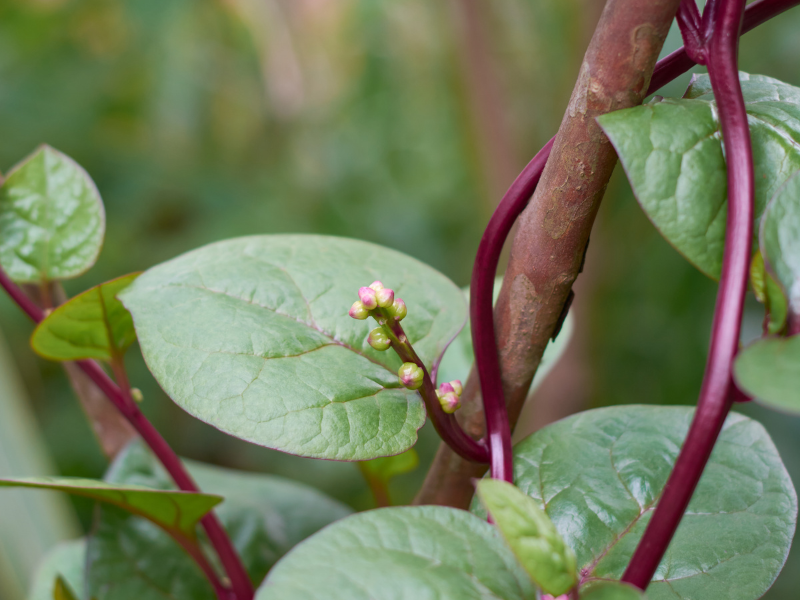
Grow Malabar Spinach in Pakistan: Moji Mall Guide
Share
Growing Malabar spinach (مالابار پالک) at home is an easy and rewarding experience. Unlike regular spinach, Basella loves warm weather and grows vigorously on vines, providing thick, juicy leaves for cooking and salads. Here’s a simple guide to growing it successfully in Pakistan’s climate.
| Aspect | Details |
|---|---|
| Best Sowing Time | March to August |
| Ideal Temperature | 24°C to 32°C |
| Germination Time | 10–15 days |
| Transplant Time | 3–4 weeks after sowing |
| Spacing | 12–18 inches between plants |
| Harvest Time | 60–80 days after sowing |
Step 1: Sow Seeds 🌱
When to Sow:
- Sow seeds from March to August, when warm weather is stable.
- Ideal soil temperature for sowing is 24°C to 32°C.
- Avoid sowing in cool weather, as Basella prefers heat to grow well.
How to Sow: Soak seeds in water overnight before sowing to soften the hard seed coat. Sow seeds 1/2 inch deep in moist, compost-rich soil.
Germination Tips: Seeds sprout in 10–15 days. Keep soil moist and warm during this period for best results.
Step 2: Transplant Seedlings 🌿
When to Transplant: Transplant when seedlings have 2–3 true leaves, about 3–4 weeks after sowing.
How to Transplant: Space plants 12–18 inches apart in pots or garden beds to allow the vines to spread properly.
Aftercare: Provide a sturdy trellis or support early, as Malabar spinach vines can climb 6–10 feet easily.
Step 3: Care for Plants 🌞💧
Sunlight Needs: Malabar spinach thrives in full sun but tolerates partial shade during very hot afternoons.
Watering: Water deeply 2–3 times a week, keeping the soil consistently moist but not waterlogged.
Feeding Schedule: Mix compost into the soil before planting. Feed lightly with organic fertilizer once every 3–4 weeks to keep growth lush and green.
Step 4: Protect Plants 🐛
Common Pests: Watch for aphids, spider mites, and caterpillars feeding on tender shoots.
Natural Protection: Spray neem oil every 10–12 days (1 teaspoon neem oil + 1 liter water + few drops soap) to control pests naturally.
Common Problems:
- Yellow Leaves: Usually caused by overwatering or poor drainage — adjust watering.
- Slow Growth: May happen if plants are in too much shade — ensure good sunlight.
- Wilting Vines: Happens when soil dries out too much — maintain regular watering.
Step 5: Harvest Leaves 🌿
When to Harvest: Begin harvesting 60–80 days after sowing when vines are well-established and leaves are tender.
How to Harvest: Pick young, tender leaves and shoots by hand or scissors. Regular picking encourages new growth.
Bonus Tip: Malabar spinach is a perennial in warm climates — with good care, it can keep producing leaves for months.
FAQs
Can I grow Malabar spinach in pots?
Yes, use large pots (12–14 inches wide) with a strong trellis for vine support.
Is Malabar spinach the same as regular spinach?
No, Malabar spinach is a tropical vining plant, while regular spinach prefers cooler weather and grows as a low leafy plant.
How tall does Malabar spinach grow?
With support, vines can grow 6–10 feet tall or more.
Can Malabar spinach grow in partial shade?
Yes, it tolerates partial shade but grows more vigorously with full sun.
How often should I harvest Malabar spinach?
You can harvest leaves every 7–10 days once the plant is well-established.
Growing Malabar spinach at home is perfect for Pakistan’s warm climate. With just a little water, sunlight, and support, you’ll have a steady supply of fresh, nutritious greens all summer long — healthier and tastier than market produce.

